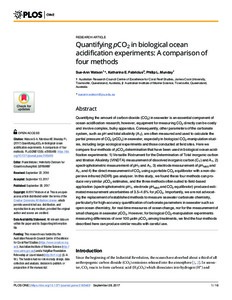| dc.contributor.author | Watson, Sue-Ann | |
| dc.contributor.author | Fabricius, Katharina E. | |
| dc.contributor.author | Munday, Philip L. | |
| dc.date.accessioned | 2020-03-12T19:47:15Z | |
| dc.date.available | 2020-03-12T19:47:15Z | |
| dc.date.issued | 2017 | |
| dc.identifier.citation | Watson, S-A.; Fabricius, K.E. and Munday, P.L. (2017) Quantifying pCO2 in biological ocean acidification experiments: A comparison of four methods. PLoS ONE 12 e0185469, 16pp. DOI: https://doi.
org/10.1371/journal.pone.0185469 | en_US |
| dc.identifier.uri | http://hdl.handle.net/11329/1236 | |
| dc.identifier.uri | http://dx.doi.org/10.25607/OBP-751 | |
| dc.description.abstract | Quantifying the amount of carbon dioxide (CO2) in seawater is an essential component of
ocean acidification research; however, equipment for measuring CO2 directly can be costly
and involve complex, bulky apparatus. Consequently, other parameters of the carbonate
system, such as pH and total alkalinity (AT), are often measured and used to calculate the
partial pressure of CO2 (pCO2) in seawater, especially in biological CO2-manipulation studies,
including large ecological experiments and those conducted at field sites. Here we
compare four methods of pCO2 determination that have been used in biological ocean acidification
experiments: 1) Versatile INstrument for the Determination of Total inorganic carbon
and titration Alkalinity (VINDTA) measurement of dissolved inorganic carbon (CT) and AT, 2)
spectrophotometric measurement of pHT and AT, 3) electrode measurement of pHNBS and
AT, and 4) the direct measurement of CO2 using a portable CO2 equilibrator with a non-dispersive
infrared (NDIR) gas analyser. In this study, we found these four methods can produce
very similar pCO2 estimates, and the three methods often suited to field-based
application (spectrophotometric pHT, electrode pHNBS and CO2 equilibrator) produced estimated
measurement uncertainties of 3.5±4.6% for pCO2. Importantly, we are not advocating
the replacement of established methods to measure seawater carbonate chemistry,
particularly for high-accuracy quantification of carbonate parameters in seawater such as
open ocean chemistry, for real-time measures of ocean change, nor for the measurement of
small changes in seawater pCO2. However, for biological CO2-manipulation experiments
measuring differences of over 100 μatm pCO2 among treatments, we find the four methods
described here can produce similar results with careful use. | en_US |
| dc.language.iso | en | en_US |
| dc.rights | Attribution 4.0 International | * |
| dc.rights.uri | http://creativecommons.org/licenses/by/4.0/ | * |
| dc.subject.other | pCO2 | en_US |
| dc.subject.other | Intercomparison | en_US |
| dc.title | Quantifying pCO2 in biological ocean acidification experiments: a comparison of four methods. | en_US |
| dc.type | Journal Contribution | en_US |
| dc.description.refereed | Refereed | en_US |
| dc.format.pagerange | 16pp. | en_US |
| dc.identifier.doi | 10.1371/journal.pone.0185469 | |
| dc.subject.parameterDiscipline | Parameter Discipline::Chemical oceanography::Carbonate system | en_US |
| dc.bibliographicCitation.title | PLOS One | en_US |
| dc.bibliographicCitation.volume | 12ttps://doi. org/10.1371/journal.pone.0185469 | en_US |
| dc.bibliographicCitation.issue | Article e0185469 | en_US |
| dc.description.sdg | 14.3 | en_US |
| dc.description.eov | Inorganic carbon | en_US |
| dc.description.maturitylevel | TRL 8 Actual system completed and "mission qualified" through test and demonstration in an operational environment (ground or space) | en_US |
| dc.description.bptype | Manual (incl. handbook, guide, cookbook etc) | en_US |
| dc.description.bptype | Standard Operating Procedure | en_US |
| obps.contact.contactname | Sue-Ann Watson | |
| obps.contact.contactemail | sueann.watson@jcu.edu.au | |
| obps.resourceurl.publisher | https://journals.plos.org/plosone/article?id=10.1371/journal.pone.0185469 | en_US |
 Repository of community practices in Ocean Research, Applications and Data/Information Management
Repository of community practices in Ocean Research, Applications and Data/Information Management

